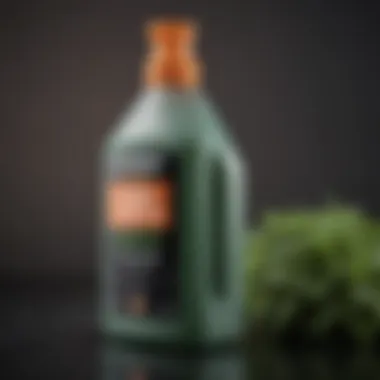Top Sprayable Weed Killers: A Comprehensive Guide


Intro
In today’s fast-paced world, managing weeds is more than just a gardening chore; it’s a critical component of maintaining healthy crops and lawns. With a diverse range of sprayable weed killers flooding the market, knowing which product suits your particular needs can feel daunting. This article unpacks the essentials surrounding these herbicides, spotlighting effective solutions that cater to both home gardeners and agricultural professionals alike.
Emphasizing a blend of practicality and ecological awareness, we'll explore the formulations, applications, and environmental considerations tied to sprayable weed killers. Understanding the nuances of how these products work is essential for making informed choices that promote not only lush green landscapes but also sustainable farming practices.
Let’s dive deeper into the key concepts and terminology that will set the stage for our thorough exploration of the best sprayable weed killers available today.
Understanding Weed Killers
When delving into the realm of horticulture and agricultural practices, understanding weed killers takes center stage. This knowledge is pivotal, especially for those who spend countless hours tending to their gardens or managing larger plots of land. Weeds, with their tenacity to thrive in various conditions, can quickly become the bane of a farmer's existence. Not only do they compete for nutrients, water, and sunlight, but they also harbor pests and diseases that can significantly affect crop yields.
Identifying effective weed management tools, therefore, is not just about aesthetic appeal; it's fundamental for crop health and economic sustainability. Sprayable weed killers are particularly popular due to their ease of application and effectiveness. Armed with this knowledge, farmers and garden enthusiasts can better grasp how to protect their plants while ensuring the environment remains unharmed.
Definition and Types of Weed Killers
Weed killers, commonly referred to as herbicides, can be defined as substances designed to eliminate unwanted plants. They come in various types, each tailored to specific purposes:
- Pre-Emergent Herbicides: These are applied before weeds germinate. They create a barrier that prevents seedling development. This method is beneficial in controlling stubborn annual weeds like crabgrass.
- Post-Emergent Herbicides: These are used on existing weed growth. Their action targets established weeds, making them effective for tackling perennials such as dandelions.
- Non-Selective Herbicides: As the name suggests, these kill any plant they come into contact with. Glyphosate, a widely recognized herbicide, falls into this category, employed for industrial-scale weeding but with caution due to its broad-spectrum activity.
- Selective Herbicides: These target specific types of plants. For instance, certain formulations can eliminate broadleaf weeds while leaving grasses unharmed, which is perfect for lawn care.
- Organic Herbicides: Made from natural ingredients, these products offer a more eco-friendly alternative. Ingredients like vinegar or clove oil are commonly used, appealing to those mindful of environmental implications.
"Choosing the right type of weed killer hinges on identifying the weeds and understanding their growth patterns."
How Sprayable Weed Killers Work
The mechanics behind sprayable weed killers can be fascinating. When applied, these products penetrate the weed's foliage and are absorbed through the leaves or stems. The active ingredients interact with specific biochemical processes in the plant, leading to growth disruption or death.
This action can vary significantly among different formulations:
- Translocation Herbicides: These move within the plant from the point of contact to other areas, reaching the roots to ensure a comprehensive kill.
- Contact Herbicides: They target the plant where they touch, requiring thorough coverage for optimal effect. Missing spots can result in weeds surviving the application.
Moreover, the timing of application plays a significant role. Applying these products during a plant's vulnerable growth stages enhances effectiveness, allowing for swift eradication before they establish their foothold in the soil.
By comprehending these nuances of weed killer usage, individuals can make informed choices tailored to their specific gardening or agricultural needs. This knowledge is crucial for effective weed management, ensuring healthier crops and more productive gardens.
Criteria for Selecting Sprayable Weed Killers
Selecting the right sprayable weed killer is like picking the right tool for a job; the wrong choice can lead to more headaches than a hangover. With a plethora of options flooding the market, understanding how to choose the best one is crucial. Each weed killer has its unique formula and target profile, meaning the consequences of an ill-informed decision can range from wasted money to unintended environmental damage.
Identifying Target Weeds
The first step in selecting an effective sprayable weed killer involves identifying the weeds that you’re up against. Different weeds have varying life cycles and resistance traits. For instance, Broadleaf weeds like dandelions demand a different approach than perennial weeds such as bindweed. By pinpointing the specific weed types invading your garden or field, you can select a product formulated to tackle those pests specifically.
Some key considerations include:
- Life Cycle: Is the weed annual or perennial?
- Growth Habitat: Observe areas these weeds are thriving in.
- Resistance: Understanding if the weed has shown resistance to certain herbicides can help avoid ineffective treatments.
Consult local extension services or gardening forums like reddit.com where fellow gardeners may share insights on their experiences with specific weeds in your area.
Assessing Environmental Impact
A responsible choice goes beyond effectiveness; it means considering the environmental footprint of your weed killer. Some herbicides can linger in the soil, leach into waterways, or harm desirable plant life. This reality can complicate the decision-making process, especially for those who take pride in maintaining eco-friendly practices.
- Chemical Composition: Understanding ingredients and their potential risks is paramount.
- Run-off Potential: Consider how much rain or overwatering might wash the chemical away.
- Soil Health: Some weed killers can disrupt soil microorganisms essential for healthy crop growth.
Key insight: Always weigh the benefits of weed control against possible harm to your ecosystem. You might want to explore organic options if your assessment leans heavily toward environmental concerns.
Evaluating Safety for Humans and Pets


Your garden doesn’t only belong to the weeds; it’s likely home to pets, children, and maybe a few curious squirrels as well. Thus, the safety of any chosen weed killer must be a top priority. Many commercial products carry warnings about their toxicity levels, detailing potential effects on humans and animals.
When assessing safety:
- Read Labels: Manufacturers provide safety sheets, outlining any regulations you might follow.
- Application Methods: Some methods may expose others, including non-target organisms.
- Post-Application Precautions: Knowing how long to keep children and pets away after application is crucial to minimize risks.
Investing in safer alternatives might be prudent, especially in more crowded regions of the garden.
Cost-Effectiveness Analysis
Balancing your budget with the need for effective weed management can be a real tightrope walk. The cheapest option might not often deliver bang for your buck, while pricier products don’t guarantee superior performance. To thoroughly evaluate cost-effectiveness:
- Evaluate Application Rates: Higher potency formulas often require less product per use, making them more cost-efficient in the long run.
- Long-Term Efficacy: A product that provides lasting results will reduce the need for frequent applications.
- User Reviews: Examine testimonials on platforms like facebook.com where real users share their results, giving you a clearer picture of effectiveness relative to price.
By framing your selection process around these critical criteria, you're not only setting yourself up for success but also potentially ensuring the sustainability of your gardening practices. Remember, making wise choices in weed management is a significant step toward nurturing a healthy garden.
Popular Sprayable Weed Killers and Their Features
Sprayable weed killers hold a significant role in the battle against unwanted vegetation, providing gardeners and farmers tools that make weed management less of a chore. The choice of which weed killer to use is influenced by various factors, including effectiveness, safety, and application methods. This section will delve into the prominent types of sprayable weed killers on the market, pinpointing their features, uses, and some considerations to keep in mind.
Glyphosate-Based Products
Glyphosate-based herbicides are widely recognized for their effectiveness in controlling a broad-spectrum of weeds. These products work by inhibiting a specific enzyme pathway essential for plant growth, leading to the eventual destruction of the targeted weeds. Some well-known brands include Roundup and Ranger Pro. Notable features of glyphosate include:
- Speed of action: Many glyphosate formulations can visibly reduce weed growth in just hours to days after application.
- Systemic action: Once absorbed by the leaves, glyphosate moves through the entire plant, targeting even roots that might not be visible. This trait makes it particularly effective against perennial weeds.
- Versatility: Suitable for both residential gardens and larger agricultural settings, these products can be utilized effectively in various environments.
However, it's important to be mindful of glyphosate's environmental impact and its potential association with health concerns.
Pre-Emergent Herbicides
Pre-emergent herbicides are a preventative strategy aimed at stoping weed seeds from germinating. These products are best applied before the weeds sprout, essentially creating a chemical barrier in the soil. Popular pre-emergent products include Prodiamine and Dithiopyr. Their key features include:
- Timing is critical: For effectiveness, application must be timed accurately during specific windows before weeds emerge.
- Long-term control: They offer extended protection against various broadleaf and grassy weeds, reducing the need for additional treatments throughout the growing season.
- Soil residue: Many pre-emergent herbicides have a soil residual activity, meaning they can help prevent weed growth for an extended period after application.
One must be cautious, however; certain pre-emergents may also affect desirable plant seeds if misapplied.
Post-Emergent Herbicides
Post-emergent herbicides are applied to actively growing weeds and are designed to deal with weeds that have already broken through the soil. These products come in selective and non-selective formulations. Products like Ortho GroundClear exemplify post-emergent offerings. The benefits include:
- Targeted action: Selective post-emergents focus on particular weeds, allowing for safe application around desirable plants.
- Immediate results: Unlike pre-emergent products, their action can be seen within days, making them suitable for urgent weed issues.
- Adaptability: They can be used in various contexts—from lawns to gardens, ensuring that their application can be versatile.
One downside to consider is that repeated use may lead to tolerance developments in weed species, requiring a rotation of active ingredients.
Organic and Natural Formulations
For those inclined towards eco-friendly options, organic and natural formulations present an appealing alternative. Products like vinegar-based herbicides or those containing clove oil, rely on natural ingredients that are often less harmful to the environment when compared to traditional chemicals. Features can include:
- Less environmental impact: Many natural formulations break down more quickly in the environment and have reduced toxicity to beneficial insects and creatures.
- Safer for use around pets and children: With a focus on organic ingredients, these products can often be used with greater peace of mind, especially in residential settings.
- Diverse application: Organic options can be used in various applications, from gardening to landscaping, accommodating diverse user needs.
A few challenges may arise, including potential limitations in effectiveness against tougher weed species and faster dissipation, which may require more frequent applications.
In summary, understanding the various sprayable weed killers is crucial for anyone looking to manage weeds effectively. Each type has its unique set of advantages and considerations, making it essential for users to weigh their options based on their specific needs and circumstances. Choosing wisely can lead to healthier gardens and reduced unwanted vegetation.
Application Techniques for Sprayable Weed Killers
Understanding the right application techniques for sprayable weed killers is essential for any farmer or gardening enthusiast. Applying these products effectively not only maximizes their weed-killing potential but also minimizes negative impacts on the surrounding environment and desired crops. The importance of mastering application methods cannot be underestimated; ineffective techniques can lead to wasted resources, increased resistance in weeds, and potential harm to beneficial plants.
Best Practices for Application


Effective application begins with several best practices that should be adhered to:
- Read the Label: Always start by reading the manufacturer's guidelines. It might seem tedious, but knowing the specifics—like the recommended dilution rate and application method—is key to success.
- Use Appropriate Equipment: For larger areas, commercial sprayers might be necessary, but for home gardens, handheld or backpack sprayers can often do the job perfectly. Ensure your equipment is calibrated properly to avoid oversaturation.
- Ensure Uniform Coverage: The goal is to cover weeds uniformly, without missing spots or applying too heavily. Using a steady, back-and-forth motion can help achieve more consistent coverage.
By incorporating these best practices, users can greatly enhance the effectiveness of the weed killer while conserving resources.
Timing and Frequency of Application
Timing is everything when it comes to applying weed killers. Using them at the right growth stage can make a significant difference:
- Ideal Growth Stages: Post-emergent herbicides often work best during the early growth phase of weeds when they are most vulnerable. Conversely, some pre-emergent products should be applied before weed seeds germinate.
- Weather Conditions: Ideal conditions, like calm and dry weather, play a pivotal role. Wind can carry herbicides to unintended targets, while rain can dilute or wash away the product before it has a chance to work.
You may want to keep a calendar to track when to spray and when to repeat the application. This can lead to a more planned approach and better weed management.
Safety Precautions During Application
Safety considerations cannot be taken lightly, especially when handling potent herbicides:
- Personal Protective Equipment (PPE): Wearing gloves, goggles, and a mask significantly reduces the risk of exposure to harmful chemicals. Even experienced users should not skip this step.
- Avoiding Contamination: Make sure not to apply near water sources to prevent contamination. Grass clippings or compost piles can also absorb poison, so keep those areas clear during application.
- Children and Pets: Always keep children and pets away from treated areas for a specified time post-application, as indicated on the product label.
Remember: It’s far easier to prevent accidents than to manage them, so taking safety precautions is crucial to protect both yourself and the environment.
In summary, mastering spray application techniques is fundamental for anyone looking to control weeds effectively while minimizing adverse effects. Regularly reminding oneself of best practices, monitoring proper timing, and observing safety measures will not only yield better results but also contribute to more sustainable gardening and farming practices.
Impact on Soil and Crop Health
When considering the application of sprayable weed killers, one cannot overlook their potential ramifications on soil and crop health. This aspect is paramount, especially in an era where sustainable agricultural practices are increasingly vital. It's not just about getting rid of undesirable plants; it's about ensuring that the soil remains fertile and the crops thrive.
The soil acts as a living ecosystem, home to various microorganisms that play crucial roles in nutrient cycling, organic matter decomposition, and overall soil structure enhancement. Using the wrong type of weed killer can disrupt these essential functions, leading to long-term degradation of soil quality. Therefore, understanding the impacts of these products, both short-term and long-term, is critical.
Short-Term vs Long-Term Effects
Short-Term Effects
In the immediate aftermath of applying a weed killer, farmers might notice rapid results—plants wilting and dying within hours or days. This effectiveness can be gratifying, but one must be cautious. The active ingredients in many weed killers can also affect beneficial plants and microorganisms in the vicinity. For instance, glyphosate is known for its systemic action, which means it not only affects targeted weeds but can also influence nearby crops, particularly if the herbicide drifts during application.
Long-Term Effects
Long-term implications are where the stakes get higher. Regular use of certain herbicides can lead to resistance in weed populations, requiring even stronger chemicals or alternative methods of control. This cycle can cause soil health to decline as it becomes less microbial-friendly, leading to greater problems such as erosion or nutrient leaching. Furthermore, soil compaction and reduced organic matter can occur, ultimately resulting in lower crop yields over time.
"The health of the soil is a direct reflection of the management practices employed by farmers. It's imperative to align weed management strategies with soil health goals to ensure a sustainable future."
Influence on Soil Microorganisms
Microorganisms serve as the unsung heroes of soil functioning, facilitating critical processes that enhance crop productivity. They'll work tirelessly, turning organic materials into nutrients, and supporting plant growth. However, the application of certain weed killers poses a threat to this delicate balance.
When herbicides, especially potent ones, are sprayed, they can inadvertently kill off beneficial microorganisms. For example, the application of synthetic herbicides can alter the soil pH and reduce the population of bacteria and fungi essential for plant health. In turn, less microbial activity can diminish soil's ability to retain water, absorb nutrients, and even recover from stress.
On a potentially positive note, some organic formulations promote beneficial microorganisms while curbing weed growth. This approach allows one to tackle the problem while maintaining or even enhancing soil health, thus encouraging a more sustainable form of agriculture that seeks synergistic relationships rather than strictly adversarial ones.
Comparative Analysis of Top Brands
When it comes to tackling stubborn weeds in your garden or farm, understanding the competitive landscape of sprayable weed killers is crucial. This section focuses on a comparative analysis of top brands. The importance lies in making informed choices that can either save you time, effort, or lead to disastrous outcomes if you pick a subpar product. Each brand has its own strengths and weaknesses, reflected in factors such as product formulation, efficacy, environmental impact, and price, which are vital considerations for any agricultural enthusiast or farmer.
By weighing these elements, you can better navigate the myriad options on the shelf, ensuring you find the right fit for your específicas needs. Making side-by-side comparisons allows you to assess not only which product does the job best, but also which aligns with your principles—be they eco-friendliness, safety for pets, or cost-effectiveness. Let's explore the top three brands, analyzing their products in detail.
Brand A: Product Overview and Efficacy
Brand A offers a powerful glyphosate-based herbicide that has drawn attention from both home gardeners and professional landscapers. Its active ingredient works by inhibiting a specific enzyme pathway necessary for plant growth. Users often report noticeable weed control within a few days of application, making it advantageous for those wanting quick results.
Key Features:
- Fast-acting formula, often yielding results in 1-3 days
- Can be used on both grassy and broadleaf weeds
- Suitable for various applications, from driveways to garden beds


However, it's worth noting that while effective against many weeds, it may also affect desirable plants if not applied with care. This necessitates an extra layer of caution, especially in gardens with a variety of flora.
Brand B: Product Overview and Efficacy
Brand B markets itself as a more environmentally conscious alternative. Its main formulation includes natural ingredients that are less likely to harm surrounding plants and soil health. Reviews often highlight its safer profile, especially for users concerned about pets or children playing in treated areas.
Key Features:
- Utilizes a blend of natural oils effective against a range of common weeds
- Biodegradable formula appealing to eco-friendly gardeners
- Designed for spot treatment, reducing waste and environmental impact
While its performance might not match the speed of glyphosate-based killers, many users appreciate the peace of mind that comes with using a product that prioritizes safety. The trade-off here is typically a longer time required for full efficacy.
Brand C: Product Overview and Efficacy
Brand C takes a different route with a pre-emergent herbicide aimed primarily at preventing weeds before they even sprout. This is a proactive approach that many farmers and gardeners find very effective, especially in managing larger areas prone to certain invasive species.
Key Features:
- Prevents various annual weeds from germinating
- Excellent for larger agricultural settings
- Often combined with fertilization properties to enhance soil
For those looking to take preventive measures, Brand C stands out. However, users must apply the product at precise times to get the maximum benefit.
The key takeaway here is that effective weed management often involves proactive strategies, particularly within large-scale agricultural operations.
This comparative analysis highlights the diverse offerings that each brand provides. Regardless of your personal preferences or specific agricultural needs, understanding these products can empower you to make well-informed decisions.
Future Trends in Weed Management
The landscape of agriculture is ever-evolving, and so are the ways we manage weeds. This section zeroes in on the future trends that are shaping weed management practices. As we stand at the crossroads of technological advancement and ecological necessity, understanding these trends becomes imperative. They not only redefine how we approach weed control but also address growing concerns about environmental impact and agronomic efficiency.
Innovations in Herbicide Formulations
The world of herbicides is witnessing an influx of innovations aimed at making weed control more effective and environmentally friendly. Among these advancements, one can spot the rise of selective herbicides that target specific weeds while minimizing harm to crops and beneficial plants. Such formulations often utilize novel active ingredients that disrupt the biological processes of weeds without affecting surrounding flora.
Moreover, the concept of microencapsulation is gaining traction. This technology allows for herbicides to be enclosed in a protective coating, which releases the active ingredient slowly over time. This means less frequent applications for farmers, reducing both labor and chemical runoff into the soil and water systems. With precision agriculture tools, farmers can also apply these herbicides more accurately, reducing wastage and lowering costs.
"Innovations in herbicide formulations represent a shift towards targeted, sustainable approaches for effective weed management."
Ecological Approaches to Weed Management
In recent years, there has been a significant pivot towards ecological weed management. This includes integrated pest management (IPM) techniques, which encourage a holistic view of landscape management. IPM utilizes a combination of biological, cultural, mechanical, and chemical practices to control weeds in a manner that is both effective and resource-efficient.
Modern strategies also incorporate cover cropping and crop rotation as means to suppress weed growth. By planting specific cover crops during off-seasons, farmers can enhance soil health, suppress weeds, and even attract beneficial insects that prey on weed-seed-producing pests. This symbiotic relationship not only works wonders for soil biodiversity but also reduces the reliance on herbicides.
Additionally, the concept of utilizing drones and AI technology for targeted weed detection is becoming more popular. These technologies can identify weed presence at a micro level, enabling farmers to target specific areas that require intervention rather than applying herbicides broadly. This not only enhances effectiveness but aligns with a more sustainable approach to agriculture.
Ending on Sprayable Weed Killers
In the realm of weed management, understanding the landscape of sprayable weed killers is not just beneficial—it's essential. These products vary significantly in terms of composition, effectiveness, and environmental impact. A well-rounded conclusion on sprayable weed killers brings into focus various elements that enable agriculture farmers and gardening enthusiasts to navigate this complex topic successfully.
Summarizing Key Considerations
When summarizing the key considerations about sprayable weed killers, a few pivotal points come to mind:
- Target Weeds: Different herbicides are formulated to combat specific types of weeds. Understanding which weeds you are facing can save time and resources. For instance, knowing that pokeweed is notoriously stubborn prompts one to choose a product explicitly known for its effectiveness against it.
- Active Ingredients: Familiarity with the various active ingredients in weed killers can empower users to select products that align with their values—be it organic gardening or chemical usage mitigations. While glyphosate remains popular, alternatives like ammonium nonanoate also deserve attention for those leaning towards greener options.
- Application Timing: The efficacy of sprayable weed killers is greatly influenced by timing. Applying these at the right stage of weed growth ensures maximum effectiveness, mitigating the need for repeated treatments.
- Environmental Considerations: The impact of herbicides on surrounding plants, soil health, and local ecosystems cannot be overlooked. Some products are more biodegradable than others, which can be a significant factor for those mindful of ecological footprints.
"The right weed killer can save more than just time; it can mean the difference between a bountiful harvest and a patch of land laid siege by unruly weeds."
Encouragement for Informed Choices
It’s crucial to empower readers to make informed decisions when selecting sprayable weed killers. Here are a few strategies:
- Research Before You Buy: Don't just grab the first product off the shelf. Investigate various brands and their features. User reviews and expert opinions can provide insights not always visible on the label.
- Trial and Error: Don’t hesitate to experiment on a small scale before a large application. This method can reveal which products work best for your particular situation without risking larger areas.
- Stay Updated: The field of weed management is continually evolving, with new formulations and methodologies emerging regularly. Engaging with agricultural forums, such as those found on Reddit, or professional networks can keep you in the loop.
By considering these factors and remaining proactive in their approach, readers can navigate the world of weed management with confidence. This conclusion attempts to encapsulate the essence of choosing the right sprayable weed killers, illuminating their importance and the thoughtful considerations that accompany this task.







